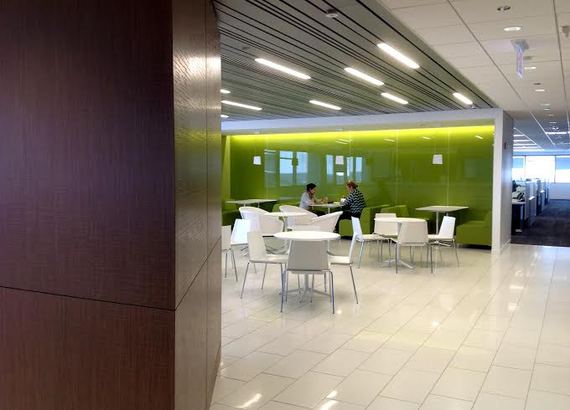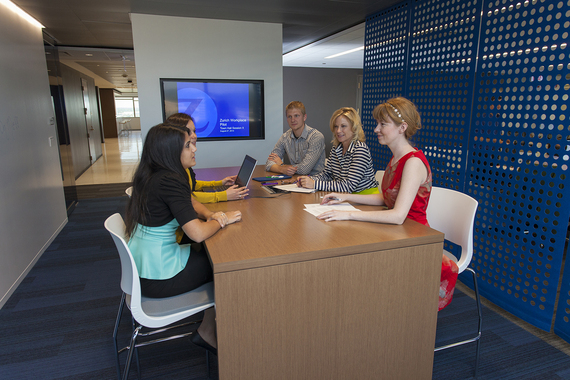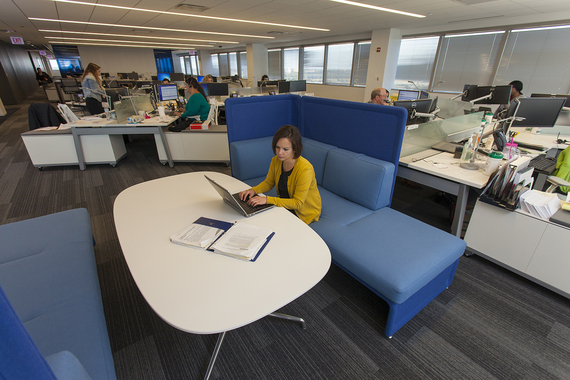Everyone seems to either want to emulate Google's offices, or rip them apart. The truth is, what is great about Google's offices doesn't work for everyone. This exemplifies a major challenge that the field of interior design faces -like everything else in America- everyone is looking for a prescriptive, one size fits all, easy solution. However, creating great design is not that simple. Meaningful design requires a deep understanding about exactly who the design is for and how it must function, not just how to make it look better. So, if Google got it wrong, then Zurich got it right.
Zurich North America exemplifies how to be smart about investments in design and, perhaps more importantly, people. With their new headquarters opening in 2016, Zurich's focus is to ensure its new headquarters is best suited to meet employee needs. To help achieve this, they created an extensive workplace pilot program testing different workspace designs and measuring results. More than 150 employees spent three weeks evaluating each of four uniquely configured office neighborhoods before selecting a final design. Zurich's partner in this project, Cannon Design- a global integrated design firm, helped Zurich to define the four unique work environments based on industry trends and observations.
Jennifer Kyung, Headquarters Business Lead at Zurich said, "We use data to make other decisions, why wouldn't we use the same approach to make decisions for people to be effective in the workplace? This building is not just a new building, but a catalyst on our journey to be the best." Meg Osman, Executive Director of CannonDesign's Corporate/Commercial Practice echoed, "We have learned a lot as part of this process. Anytime you're working on something without the proper data and measurements, the design aspect can be quite subjective - and that can be frustrating. Here, at Zurich, they will go into the new space confident they have the right solution."
The team then measured results before, during and after the pilot program via focus groups and employee surveys. From the data collected, they were able to craft a solution for the new Zurich Headquarters that is designed uniquely to fit the culture of their organization. In addition to the expected aesthetic benefits of great design, this space will also be a catalyst to foster development of their culture and help employees be more productive.
The below list summarizes key findings from the workplace pilot:
•Frequency of interaction within teams increased 19%
•The average time people spent waiting for responses decreased 62%
•64% of those involved said communication with their group had improved after working in the pilot settings.
•Satisfaction with flexibility to use different spaces over the course of a day increased 64%
•57% said they weren't just happy with the pilot workplace, but also enjoyed doing their work more in it.
•Enclaves (shared small private rooms) were people's favorite aspect of the pilot, chosen by 65% of participants, while the social hub and access to natural light were the second and third most favored aspects.
•Participants said they spent half as much time at colleagues' desks than they did before but more time in nearby collaborative spaces, effectively taking noisy talking away from desks.
•50% said they went to a private room and 40% to a quiet part of the floor when they needed to concentrate in the pilot, versus only 20% and 12% in the old workplace.
One of the biggest realizations for the Zurich team was that with the new solution, satisfaction with the workplace increased for all generations. Osman said, "The real cautionary tale is this: even though there is so much press about generations - and that is all very real - you can't apply it as a one size fits all. One of our biggest findings was that there was no clear preferences by generations in this research. Young generations at Zurich said the same thing as the seasoned employees. Everyone out there is selling beanbag chairs to new generations in workplace. The reality is if it doesn't work for what they are trying to get done at work, it's not going to work. To assume that blanket response could be inherently incorrect."
Although there is no formal ROI (yet) from the time and investment in creating these test spaces, the team easily came up with examples where they have saved money and driven decisions that will make better use of real estate. Based on trends in the industry, the team originally included small enclaves with casual "club" seating in the test spaces. What they discovered was that Zurich employees didn't find that furniture appropriate for a work setting. Osman says, "It was accepted in social hubs, but not in the formal work environment." Kyung agreed, "Without conducting these pilots, we may have put that in, but that would have been dead space. It's a trend in this industry, but we discovered it doesn't work for us. In contrast, we discovered that the social hubs were much more utilized, so we invested more there." These are all financially sound decisions we are able to make because we have this data."
Osman concluded with this: "We are proud that with 100% hit rates no one wanted to leave the pilot. This includes managers, various generations and distinctive departments. We thought managers leaving private offices would be our toughest critics, but unanimously no one wanted to go back. This process has allowed them to find the most efficient and effective ways to getting their jobs done every day."



